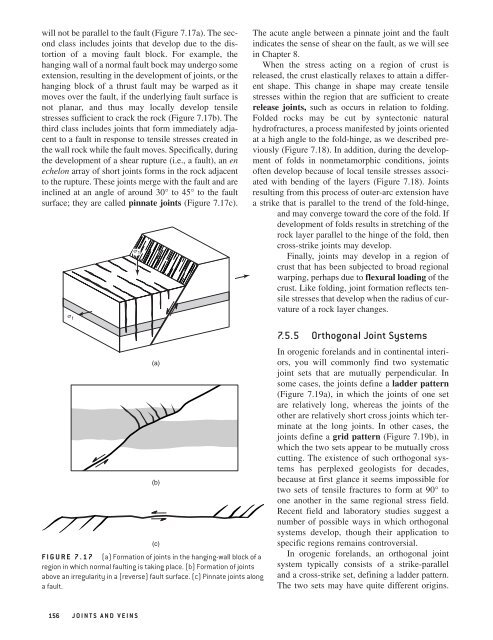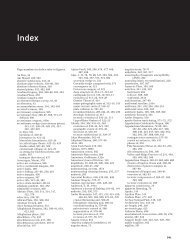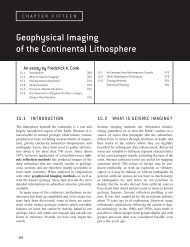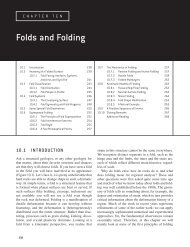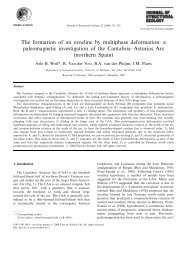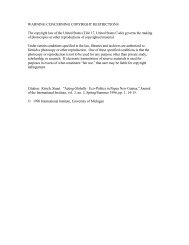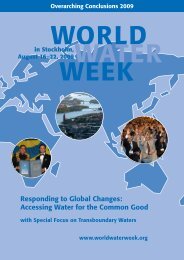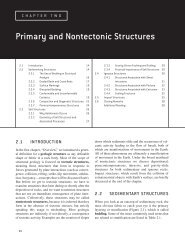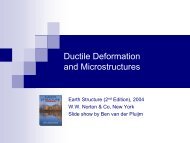Joints and Veins - Global Change
Joints and Veins - Global Change
Joints and Veins - Global Change
- No tags were found...
Create successful ePaper yourself
Turn your PDF publications into a flip-book with our unique Google optimized e-Paper software.
2917-CH07.pdf 11/20/03 5:11 PM Page 156will not be parallel to the fault (Figure 7.17a). The secondclass includes joints that develop due to the distortionof a moving fault block. For example, thehanging wall of a normal fault bock may undergo someextension, resulting in the development of joints, or thehanging block of a thrust fault may be warped as itmoves over the fault, if the underlying fault surface isnot planar, <strong>and</strong> thus may locally develop tensilestresses sufficient to crack the rock (Figure 7.17b). Thethird class includes joints that form immediately adjacentto a fault in response to tensile stresses created inthe wall rock while the fault moves. Specifically, duringthe development of a shear rupture (i.e., a fault), an enechelon array of short joints forms in the rock adjacentto the rupture. These joints merge with the fault <strong>and</strong> areinclined at an angle of around 30° to 45° to the faultsurface; they are called pinnate joints (Figure 7.17c). t 1The acute angle between a pinnate joint <strong>and</strong> the faultindicates the sense of shear on the fault, as we will seein Chapter 8.When the stress acting on a region of crust isreleased, the crust elastically relaxes to attain a differentshape. This change in shape may create tensilestresses within the region that are sufficient to createrelease joints, such as occurs in relation to folding.Folded rocks may be cut by syntectonic naturalhydrofractures, a process manifested by joints orientedat a high angle to the fold-hinge, as we described previously(Figure 7.18). In addition, during the developmentof folds in nonmetamorphic conditions, jointsoften develop because of local tensile stresses associatedwith bending of the layers (Figure 7.18). <strong>Joints</strong>resulting from this process of outer-arc extension havea strike that is parallel to the trend of the fold-hinge,<strong>and</strong> may converge toward the core of the fold. Ifdevelopment of folds results in stretching of therock layer parallel to the hinge of the fold, thencross-strike joints may develop.Finally, joints may develop in a region ofcrust that has been subjected to broad regionalwarping, perhaps due to flexural loading of thecrust. Like folding, joint formation reflects tensilestresses that develop when the radius of curvatureof a rock layer changes.(a)(b)(c)FIGURE 7.17 (a) Formation of joints in the hanging-wall block of aregion in which normal faulting is taking place. (b) Formation of jointsabove an irregularity in a (reverse) fault surface. (c) Pinnate joints alonga fault.7.5.5 Orthogonal Joint SystemsIn orogenic forel<strong>and</strong>s <strong>and</strong> in continental interiors,you will commonly find two systematicjoint sets that are mutually perpendicular. Insome cases, the joints define a ladder pattern(Figure 7.19a), in which the joints of one setare relatively long, whereas the joints of theother are relatively short cross joints which terminateat the long joints. In other cases, thejoints define a grid pattern (Figure 7.19b), inwhich the two sets appear to be mutually crosscutting. The existence of such orthogonal systemshas perplexed geologists for decades,because at first glance it seems impossible fortwo sets of tensile fractures to form at 90° toone another in the same regional stress field.Recent field <strong>and</strong> laboratory studies suggest anumber of possible ways in which orthogonalsystems develop, though their application tospecific regions remains controversial.In orogenic forel<strong>and</strong>s, an orthogonal jointsystem typically consists of a strike-parallel<strong>and</strong> a cross-strike set, defining a ladder pattern.The two sets may have quite different origins.156 JOINTS AND VEINS


